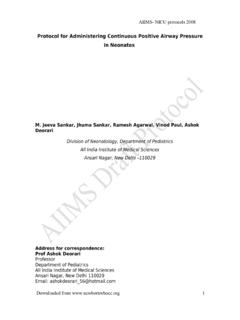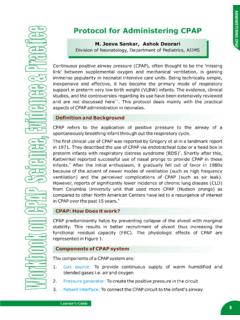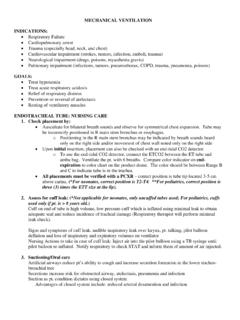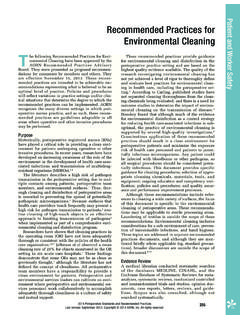Transcription of NNF Teaching Aids:Newborn Care
1 NNF Teaching Aids:Newborn Care Neonatal sepsis Slide NS -1. Definition Neonatal sepsis is defined as a clinical syndrome of bacteremia with systemic signs and symptoms of infection in the first 4 weeks of life. When pathogenic bacteria gain access into the blood stream, they may cause overwhelming infection without much localization (septicemia) or may get predominantly localized to the lung (pneumonia) or the meninges (meningitis). Slide NS -2. Importance Neonatal sepsis is the single most important cause of neonatal deaths in the community, accounting for over half of them. If diagnosed early and treated aggressively with antibiotics and good supportive care, it is possible to save most cases of neonatal sepsis. Slide NS-3. Etiology Most cases of neonatal sepsis in the community are caused by Escherichia coli and Staphylococcus aureus.
2 In hospitals, Klebsiella pneumoniae is also a common organism. Slide NS-4. Early vs. late sepsis Neonatal sepsis can be classified into two sub-types depending upon whether the onset of symptoms is before 72 hours of life (early onset) or later (late onset). Early-onset infections are caused by organisms prevalent in the maternal genital tract or in the delivery area. The associated factors for early-onset sepsis include low birth weight, prolonged rupture of membranes, foul smelling liquor, multiple per vaginum examinations, maternal fever, 1. NNF Teaching Aids:Newborn Care difficult or prolonged labour and aspiration of meconium. Early onset sepsis manifests frequently as pneumonia and less commonly as septicemia or meningitis. Late-onset septicemia is caused by the organisms thriving in the external environment of the home or the hospital.
3 The infection is often transmitted through the hands of the care-providers. The onset of symptoms is usually delayed beyond 72 hours after birth and the presentation is that of septicemia, pneumonia or meningitis. The associated factors of late-onset sepsis include: low birth weight, lack of breastfeeding, superficial infections (pyoderma, umbilical sepsis), aspiration of feeds, disruption of skin integrity with needle pricks and use of intravenous fluids. These factors enhance the chances of entry of organisms into the blood stream of the neonates whose immune defences are poor as compared to older children and adults. Slide NS-5, 6, 7,8. Clinical features The manifestations of neonatal septicemia are often vague and therefore demand a high index of suspicion for early diagnosis (Table I). The most common and characteristic manifestation is an alteration in the established feeding behavior in late onset sepsis and respiratory distress in early onset sepsis.
4 The baby, who had been active and sucking well, gradually or suddenly, becomes lethargic, inactive or unresponsive and refuses to suckle. Hypothermia is a common manifestation of sepsis, whilst fever is infrequent. Diarrhea, vomiting and abdominal distension may occur. Episodes of apneic spells or gasping may be the only manifestation of septicemia. In sick neonates , the skin may become tight giving a hide- bound feel (sclerema) and the perfusion becomes poor (capillary refill time of over 3 seconds). Cyanosis may appear. A critical neonate may develop shock, bleeding and renal failure. 2. NNF Teaching Aids:Newborn Care TABLE 1: Clinical manifestations of neonatal sepsis Lethargy Cyanosis*. Refusal to suckle Tachypnea*. Poor cry Chest retractions*. Not arousable, comatosed Grunt*. Abdominal distension Apnea/gasping*.
5 Diarrhea Fever+. Vomiting Seizures+. Hypothermia Blank look+. Poor perfusion High pitched cry+. Sclerema Excessive crying/irritability+. Poor weight gain Neck retraction+. Shock Bulging fontanel+. Bleeding Renal failure * Particularly suggestive of pneumonia +. Particularly suggestive of meningitis The additional features of pneumonia or meningitis may be present depending upon the localization of infection in different systems and organs of the body. The evidence of pneumonia includes tachypnea, chest retractions, grunting, early cyanosis and apneic spells in addition to inactivity and poor feeding. Cough is unusual. Findings on auscultation of the chest are non-specific and non- contributory. Meningitis is often silent, the clinical picture being dominated by manifestations of associated septicemia.
6 However, the appearance of excessive or high-pitched crying, fever, seizures, blank look, neck retraction or bulging anterior fontanel are highly suggestive of meningitis. A large WHO study published in 2003 identified nine clinical features which predict severe bacterial illness in young infants 1. Feeding ability reduced 2. No spontaneous movement 3. Temperature >38 C. 4. Prolonged capillary refill time 5. Lower chest wall in drawing 6. Resp rate > 60/minute 7. Grunting 3. NNF Teaching Aids:Newborn Care 8. Cyanosis 9. H/o of convulsions Slide NS- 9,10,11,12. Diagnosis Direct method Isolation of microorganisms from blood, CSF, urine, pleural fluid or pus is diagnostic. Indirect method There are a variety of tests which are helpful for screening of neonates with sepsis. The most useful and widely used is the white blood cell count and differential count.
7 An absolute neutrophil count of < 1800 per cmm is an indicator of infection. Neutropenia is more predictive of neonatal sepsis than neutrophilia but it may be present in maternal hypertension, birth asphyxia and periventricular hemorrhage. Immature neutrophils (Band cells + myelocytes + metamyelocytes) to total neutrophils ratio (l/T) >. means that immature neutrophils are over 20 percent of the total neutrophils because bone marrow pushes even the premature cells into circulation, to fight infection. Platelet count of less than 100,000 per cmm, toxic granules on peripheral smear and gastric aspirate smears showing more than 5 leucocytes per high power field are also useful indirect evidences of infection. The micro-ESR may be elevated with sepsis and fall of > 15 mm during first hour indicates infection.
8 Acute phase reactants are also frequently used in predicting neonatal sepsis. The most widely used is C-reactive protein (CRP) which has a high degree of sensitivity for neonatal sepsis. The CRP can be affected by asphyxia, shock, meconium aspiration and prolonged rupture of membranes. There are a variety of other tests which can be used to predict sepsis but it may be difficult to perform them at all places and hence the clinical acumen remains crucial. A practical positive "sepsis screen" takes into account two 4. NNF Teaching Aids:Newborn Care or more positive tests as given below: 1. Leukopenia (TLC <5000/cmm). 2. Neutropenia (ANC <1800/cmm). 3. Immature neutrophil to total neutrophil (I/T) ratio (> ). 4. Micro ESR (> 15mm 1st hour). 5. CRP +ve If possible, lumbar puncture should be done in all cases of late onset (>72.)
9 Hours) and symptomatic early onset sepsis because 10-15 percent of them may have associated meningitis. At a small hospital, one may only depend on the CSF cells. The implications of detecting meningitis in the setting of septicemia include: the need for using antibiotics with a high CSF. penetration and provision of antibiotic treatment for at least 3 weeks, administered parenterally throughout. Treatment No investigation is required as a prerequisite to start treatment in a clinically obvious case. Early treatment is crucial. Institution of prompt treatment is essential for ensuring optimum outcome of neonates with sepsis who often reach the health care facilities late and in a critical condition. Supportive care and antibiotics are two equally important components of the treatment. It should be realized that antibiotics take at least 12 to 24 hours to show any effect and it is the supportive care that makes the difference between life and death early in the hospital course.
10 Slide NS -13,14. Supportive care The purpose of supportive care is to normalize the temperature, stabilize the cardiopulmonary status, correct hypoglycemia and prevent bleeding tendency (Table-II). The septic neonate should be nursed in a thermo neutral environment. If hypothermic, the temperature should be raised using a heat source. An intravenous line should be established. If perfusion is poor as indicated by a capillary refill time of more than 3 seconds, normal saline bolus should be infused immediately. A dextrose bolus will help correct hypoglycemia which is often present in septic infants. Vitamin K should be given to prevent bleeding. Oxygen should be provided if the 5. NNF Teaching Aids:Newborn Care infant is having retractions, grunt or cyanosis. Apneic neonates should be given physical stimulation and bag-mask ventilation , if required.










